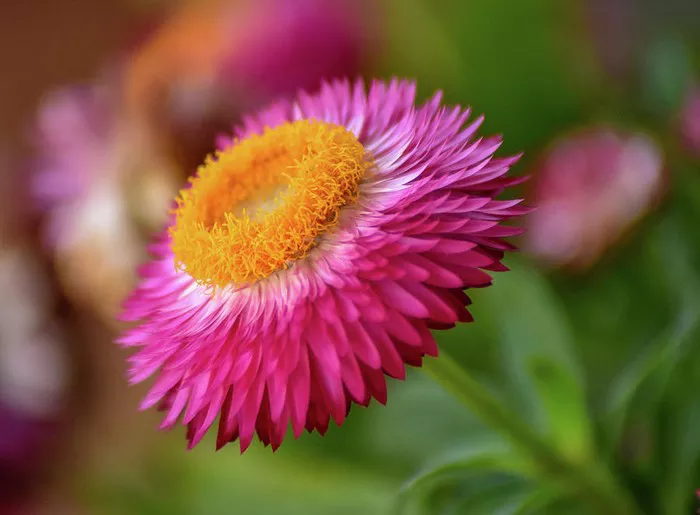Straw flowers, scientifically known as Helichrysum bracteatum, are delightful additions to any garden with their vibrant colors and long-lasting blooms. These drought-tolerant annuals are relatively easy to grow, making them a favorite among both beginner and experienced gardeners. Whether you’re looking to add a pop of color to your landscape or create beautiful dried flower arrangements, straw flowers are an excellent choice. In this guide, we’ll provide you with precise instructions on how to plant and care for these charming flowers.
Choosing the Right Location
Before planting your straw flowers, it’s crucial to select the right location in your garden. These plants thrive in full sun, so choose a spot that receives at least 6 to 8 hours of sunlight per day. Additionally, ensure that the soil is well-draining to prevent waterlogging, as straw flowers are susceptible to root rot in overly wet conditions. Sandy or loamy soil with a slightly acidic to neutral pH (6.0 to 7.0) is ideal for optimal growth.
Preparing the Soil
Prepare the soil in your chosen location by removing any weeds, rocks, or debris. Loosen the soil to a depth of about 6 to 8 inches using a garden fork or tiller, breaking up any clumps to create a fine, crumbly texture. Incorporate organic matter such as compost or well-rotted manure into the soil to improve its fertility and drainage. This step will provide essential nutrients for healthy plant growth and help retain moisture during dry spells.
Sowing Seeds
Straw flowers can be grown from seeds, which are readily available at garden centers or online. Sow the seeds directly into the prepared soil after the danger of frost has passed in spring. Scatter the seeds thinly over the soil surface, then lightly press them into the soil with your fingers or a garden rake. Aim for a spacing of about 6 to 12 inches between each seed to allow the plants room to grow.
Watering
After sowing the seeds, water the soil gently to settle it around the seeds and provide moisture for germination. Keep the soil consistently moist but not waterlogged during the germination period, which typically takes 7 to 14 days. Once the seedlings have emerged, gradually reduce the frequency of watering, allowing the top inch of soil to dry out between waterings. Deep, infrequent watering encourages the development of deep roots and helps the plants withstand periods of drought.
Fertilizing
Straw flowers are not heavy feeders, but they will benefit from occasional fertilization to support healthy growth and abundant blooms. Apply a balanced, water-soluble fertilizer once a month during the growing season, following the manufacturer’s instructions for dilution and application rates. Avoid over-fertilizing, as excessive nitrogen can lead to lush foliage at the expense of flowers.
Mulching
Mulching around straw flowers helps conserve soil moisture, suppress weeds, and regulate soil temperature. Apply a layer of organic mulch such as straw, shredded bark, or compost around the base of the plants, taking care to leave a small gap between the mulch and the stems to prevent rotting. Refresh the mulch as needed throughout the growing season to maintain its effectiveness.
Support and Deadheading
Tall varieties of straw flowers may benefit from staking or support to prevent them from flopping over in strong winds or heavy rain. Install stakes or place plant supports around the outer edges of the plants, being careful not to damage the roots or stems. As the flowers fade, promptly remove them by pinching or snipping them off at the base of the stem. Deadheading encourages continuous blooming and prevents the plants from diverting energy into seed production.
Pest and Disease Control
Straw flowers are relatively pest and disease-resistant, but they may occasionally encounter problems such as aphids, spider mites, or powdery mildew. Monitor the plants regularly for signs of pests or disease, and take appropriate action if necessary. Insecticidal soap or neem oil can help control aphids and spider mites, while improving air circulation around the plants can reduce the risk of powdery mildew. Remove and destroy any affected plant material to prevent the spread of disease.
Harvesting and Drying
One of the unique qualities of straw flowers is their ability to retain their color and shape when dried, making them popular choices for dried flower arrangements and crafts. Harvest the flowers for drying when they are fully open but before they begin to fade or show signs of wilting. Cut the stems with sharp scissors or pruning shears, leaving about 6 to 8 inches of stem attached.
To dry the flowers, hang them upside down in a warm, dry, well-ventilated area away from direct sunlight. Allow the flowers to dry completely, which may take 1 to 2 weeks depending on environmental conditions. Once dry, store the flowers in a cool, dark place until you’re ready to use them in arrangements or crafts.
Conclusion
With their bright, cheerful blooms and easy-care nature, straw flowers are a delightful addition to any garden. By following these precise instructions for planting and caring for your straw flowers, you can enjoy a season-long display of color and texture in your landscape. Whether you’re a novice gardener or a seasoned expert, growing straw flowers is a rewarding experience that will bring joy and beauty to your outdoor space.


